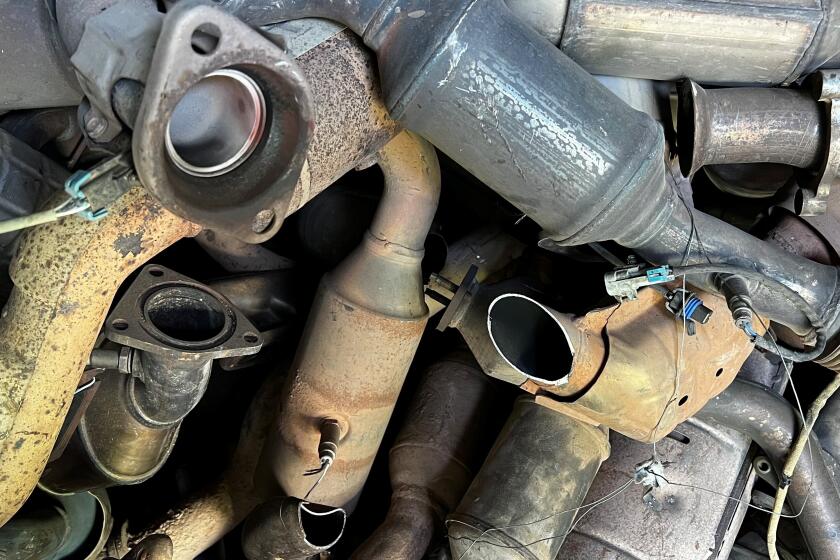Mussel quarantine in place in California due to toxin risk. What you need to know

- Share via
California public health officials have announced a quarantine on mussels that aren’t commercially harvested, cautioning that naturally occurring toxins make the species potentially poisonous to humans this time of year.
The order from the state Department of Public Health, which is issued annually, runs through Oct. 31 and warns against eating all types of sport-harvested mussels off the West Coast.
During this six-month period, mussels may have naturally occurring toxins that can cause paralytic shellfish poisoning and domoic acid biotoxins, also known as amnesic shellfish poisoning.
The emergence of biotoxins in mussels is unpredictable and their concentrations can rapidly increase, according to state public health officials.
The quarantine area extends along the California coastline from Oregon to the Mexican border — including all bays, inlets and harbors in Los Angeles County, according to public health officials.
An algae bloom off the Southern California coast has stranded so many dolphins in L.A. County that lifeguards have begun taking mental health days off to cope with the devastation, officials said.
Why do these biotoxins occur this time of year?
The amount of algae that produce toxins, also known as phytoplankton, is normally small and doesn’t pose a threat. However, when algae bloom this time of year, the number of phytoplankton dramatically increases.
This algae, some of it toxic, in turn becomes a food source for shellfish species including mussels, clams, oysters and scallops.
As the shellfish filter and eat the toxic algae, they accumulate biotoxins in their tissue, which isn’t harmful to them.
Eventually the algae decrease or disappear and the shellfish flush the toxins from their systems, according to health officials.
However, it can be several days, several months or longer before they’re safe to eat again — and there isn’t a way to visibly determine whether that’s the case.
Cooking the shellfish also does not reliably get rid of the toxins.
Levels of lead and other heavy metals spiked in L.A.’s coastal waters after the January fires, raising serious concerns for the long-term health of the marine food chain.
How dangerous are the two types of poisoning?
Consuming toxic shellfish can lead to death as there are no known antidotes, according to public health officials.
Treatment for someone who has consumed a mussel with toxins includes respiratory support until the toxins are flushed out of the body.
Since 1903, 582 total cases — including 39 deaths — have been attributed to paralytic shellfish poisoning in California.
Death can occur within 30 minutes of consuming toxic shellfish, public officials warn.
But officials say contracting the poisoning is rare, due to public health efforts to dissuade people from eating the potentially toxic mussels.
There have been no reported human cases of domoic acid poisoning in California.
Domoic acid poisoning is stranding marine mammals as warnings are issued to beachgoers of the threat posed by animals that are transformed by their illness.
What are the symptoms?
Early symptoms of paralytic shellfish poisoning include tingling of the lips and tongue that could start anywhere from a few minutes to hours after eating toxic shellfish.
These symptoms are typically followed by a loss of balance and muscular coordination, slurred speech and difficulty swallowing.
In severe cases, complete muscular paralysis and death from asphyxiation can occur.
Invasive mussel found in North America for first time, posing immediate threat in California’s Delta
Golden mussels, an invasive species that officials across the country have been worried about for years, invaded North America for the first time through the Port of Stockton.
Can I eat commercially grown mussels?
Yes. Commercially grown mussels from certified companies are exempt from the quarantine because they are required to submit frequent samples to the state Department of Public Health for testing.
If high levels of toxins are detected in a sample, the area from which it was harvested is closed until conditions become safe.
Are clams and scallops OK to eat?
Clams and scallops are not a part of the quarantine. However, officials caution that if you do consume clams and scallops you should remove and discard the digestive organs or viscera and any other dark parts.
Only the white meat of clams and scallops should be prepared for eating.
More to Read
Sign up for Essential California
The most important California stories and recommendations in your inbox every morning.
You may occasionally receive promotional content from the Los Angeles Times.














